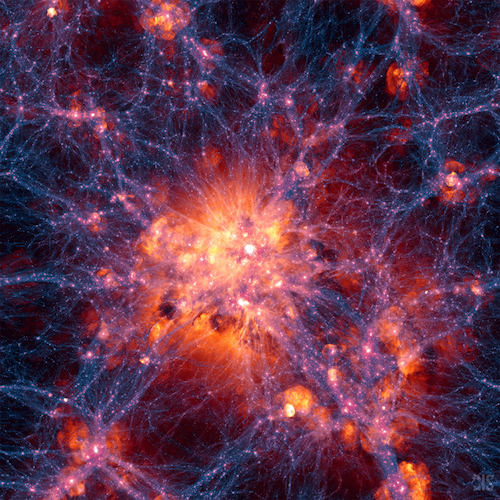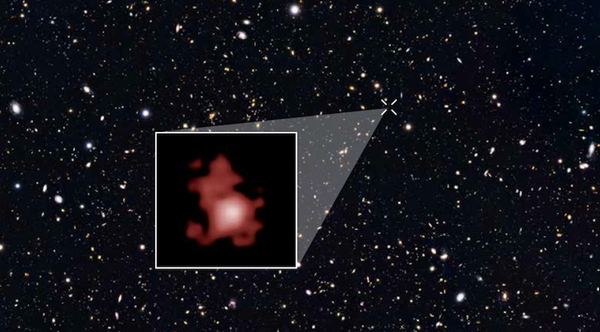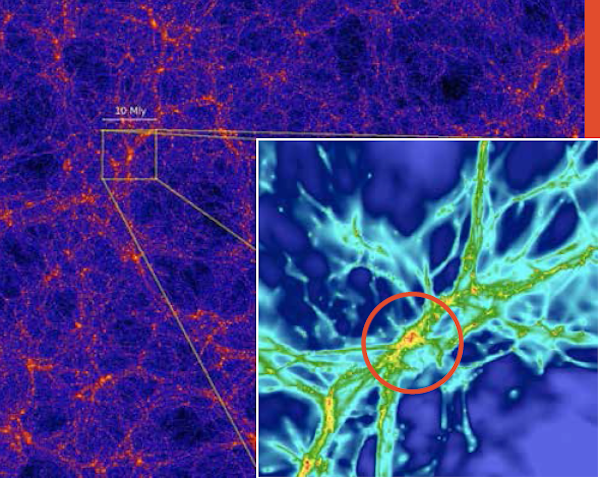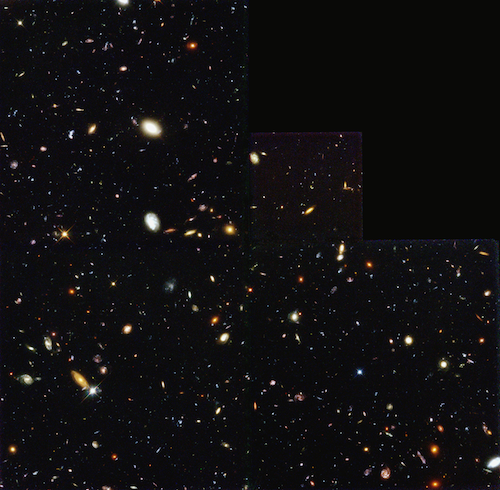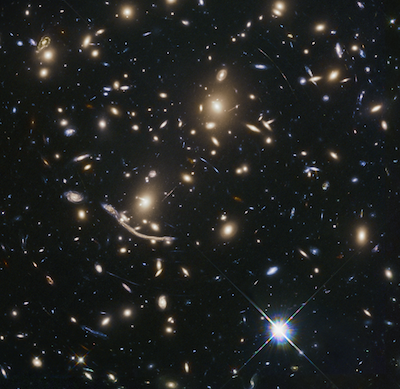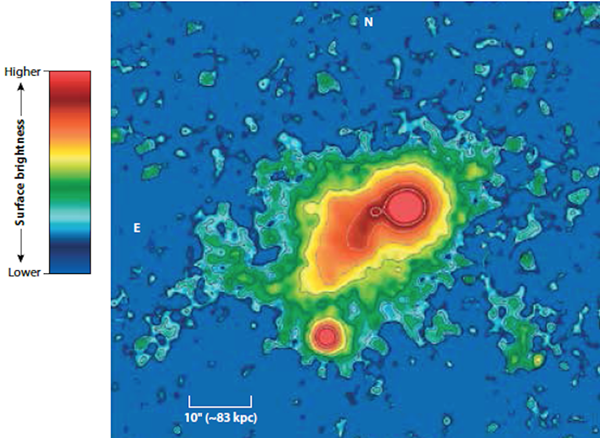In fact, space is so gigantic that when you zoom in on the most distant galaxies, you are not only seeing across the universe, but you also are looking into its past. And as any historian will tell you, there’s a lot we can learn from the past.
One of the most basic yet powerful principles of physics is that there exists a universal speed limit — 186,282 miles per second (299,792 kilometers) — which not even light can break. For most of human history, the speed of light played little to no importance in our lives. But as we developed and improved our telescopes to peer deeper and deeper into the heavens, we became acutely aware that the astronomical speed of light is challenged by the astronomical distances of space.
It takes so long for light to travel across the universe that when we observe a galaxy located near the edge of the cosmos, we are seeing it as it appeared more than 13 billion years ago. With the help of modern telescopes, we literally can peer back in time to see how the universe looked shortly after some of the earliest galaxies formed. Furthermore, in just a few short years, we may even glimpse the formation of the first galaxies themselves.
Extragalactic record-breaker
The title for earliest and most distant galaxy tends to change hands a lot these days. For now, it belongs to a galaxy known as GN-z11, which existed some 13.4 billion years ago. First described in a 2016 study published in The Astrophysical Journal, this far-flung galaxy is a whopping 32 billion light-years away — an extreme distance made possible thanks to the ever-expanding universe.
By taking spectroscopic measurements of GN-z11 with the Hubble Space Telescope, astronomers including Garth Illingworth of the University of California, Santa Cruz, looked back to when the universe was just 400 million years old — or 3 percent its current age. Although the distant galaxy during this time was just a fraction of the size of the present-day Milky Way, Illingworth and his colleagues were surprised to find GN-z11 churning out heaps of hot, young, massive stars at roughly 20 times the rate of our galaxy.
“One of the fascinating things about GN-z11 is that it is unexpectedly bright and massive for a galaxy at such an early time,” Illingworth says. “We still are not sure why this is so, but there is little doubt that it is unexpectedly luminous.”
Although astronomers already thought infant galaxies were most likely crucibles for plenty of fiercely burning stars, they did not expect to see them quite so early or in such great numbers.
“I think this comes from a perfect storm of events,” Illingworth explains. Clouds of pristine gas (almost all of it hydrogen and helium) are falling inward and colliding with each other. Bright, massive stars are forming within the metal-poor gas. And powerful shock waves are rippling through the gas itself, he explains. “All these things beget the initiation of new stars in bursts that give us the dramatic, compact, blue agglomerations of stars that we see as ‘early galaxies.’ ”
But Illingworth is quick to note that even the extremely distant GN-z11 is not one of the first galaxies to exist. Those “will be similar to GN-z11 — very small, forming stars at a great rate — but less bright, less massive, [and] with fewer stars,” he says. The first galaxies, however, will likewise appear as “dramatically young blue objects from all the star formation that is going on in bursts.”
Although we can learn a great deal about the early universe by studying specific galaxies near the edge of the cosmos, such as GN-z11, there is only so much we can conclude from individual case studies. Investigating the record-breakers is worthwhile, but studying the galactic masses can be more valuable.
In early 1996, Hubble captured the first of its famed deep-field images, the Hubble Deep Field North (HDF-N), which helped pave the way for many more extremely distant observations. The telescope focused on one small, specifically “empty” region of the sky in the constellation Ursa Major for a total of more than 100 hours. The groundbreaking snapshot astonished the public and scientists alike, and the associated research paper has since been cited well over 1,000 times.
The HDF-N image captured nearly 3,000 small galaxies — ranging from a few spirals to plenty of irregulars and ellipticals, often seen merging — packed into just one tiny field covering less than 1/20,000,000 of the sky. Though astronomers had previously studied a handful of distant galaxies, the HDF-N was the first project to get a broad census of galaxies out to redshifts of about 6, which represents a time just over a billion years after the Big Bang. Based largely on the data contained within the image, astronomers estimate ancient galaxies in the early universe collided much more frequently than they do in the present-day universe.
Over time, others have joined Hubble in its hunt for the universe’s most distant objects. The Great Observatories Origins Deep Survey (GOODS), for instance, was a joint effort between NASA and the European Space Agency (ESA) that combined deep-sky data collected over many wavelengths by the agencies’ flagship telescopes. Included were NASA’s Chandra (X-ray), Hubble (ultraviolet, optical, near-infrared), and Spitzer (infrared) space telescopes; ESA’s Herschel (far-infrared, submillimeter) and XMM-Newton (X-ray) telescopes; and a smattering of some of the world’s largest ground-based observatories. Until the survey wound down around 2010, it helped astronomers investigate a multitude of primordial galaxies out to about redshift 7, allowing them to home in on galaxies that existed in the universe’s first billion years.
But now, astronomers are setting their sights even further into the past. The new Beyond Ultra-deep Frontier Fields and Legacy Observations (BUFFALO) survey is kicking off a mission that will use six known galaxy clusters to boost Hubble’s already impressive capabilities with the help of a phenomenon known as gravitational lensing.
These six midrange BUFFALO clusters have massive gravitational wells that serve as “natural telescopes,” distorting and magnifying the light from more distant supernovae, quasars, and galaxies. By using the clusters as magnifying glasses, the program is attempting to look back to objects that existed over 13 billion years ago, which corresponds to around redshift 8. In particular, the survey aims to: determine how rapidly young galaxies formed after the Big Bang; investigate how early galaxy formation is linked to the distribution of dark matter in the universe; and identify promising targets for follow-up by the James Webb Space Telescope (JWST), which is scheduled for launch in 2021.
Unwinding the web
In the past few decades, large-scale galaxy surveys and advanced computer simulations have shown that matter in the universe is concentrated along a complicated network of interconnected filaments and knots, commonly called the cosmic web. The exceptional gravity of galaxies, galaxy clusters, and galactic superclusters (bolstered by dark matter) form the nodes of this giant web, while thin threads of neutral hydrogen (and plenty more dark matter) left over from the formation of the universe connect the galactic junctions.
Early evidence for massive cosmic structures that dwarf superclusters in size first came to light in the late 1980s with the discovery of the Pisces-Cetus Supercluster Complex. This assembly of superclusters, which includes our own Virgo Supercluster, is roughly 150 million light-years wide and about a billion light-years long.
Throughout the 1990s, astronomers continued to discover ever more expansive structures. And in 2003, Princeton University astronomer Richard Gott III and his colleagues used data from the Sloan Digital Sky Survey to identify one of the largest observed features in the cosmos, the Sloan Great Wall (SGW). This massive filament of the cosmic web, which spans the constellations Centaurus, Corvus, and Hydra, is roughly 1.4 billion light-years long and is located about a billion light-years away from Earth. Although a 2011 study suggests the wall is actually composed of three distinct structures, if it is indeed one continuous structure, it’s firmly in the top 10 of largest known bounded structures in the universe.
In 2014, a team of astronomers — led by Sebastiano Cantalupo of UC Santa Cruz and the Swiss Federal Institute of Technology in Zürich — set the precedent of using distant quasar light to probe the structure of the cosmic web. Quasars, which are the extremely luminous cores of active galaxies fueled by feeding supermassive black holes, can occasionally shine bright enough to illuminate the strands of primeval hydrogen that make up the cosmic web.
Using the 10-meter Keck Telescope in Hawaii, Cantalupo and his team observed the ancient quasar UM 287, which existed when the universe was roughly 3 billion years old. By using the bright quasar as a spotlight, the researchers were able to capture the first-ever image of a distant cosmic web filament, which took the form of a glowing, 2 million-light-year-long thread of diffuse hydrogen stretching between galaxies. They named the newfound structure the “Slug Nebula.”
“This is a very exceptional object,” Cantalupo said in a statement shortly after the nebula’s initial discovery. “It’s huge, at least twice as large as any nebula detected before, and it extends well beyond the galactic environment of the quasar.”
To this day, Cantalupo says the Slug Nebula remains “the largest [and brightest] nebula published so far.” But make sure to stay tuned, he says, because “we are working on new data and we have promising candidates for larger nebulae.”
In addition to the stunning size of the Slug Nebula, the researchers also were surprised to find out just how brightly the cosmic web filaments glowed.
By continuing to develop and build ultrasensitive telescopes, like JWST, researchers will be able to gaze deep into the past and better detect the dimly lit gas that connects bright galaxies as part of the cosmic web. And, according to Cantalupo, there’s not much better than seeing these types of things firsthand. “Simulations and models are just tools that we scientists build in order to help us understand the universe, but real understanding is only possible when this is compared — and actually challenged — by actual observations,” he says. “If we would only find what we already expect, we will have no new questions to keep feeding our curiosity, both as scientists and as human beings.”
Probing into the past
Although research into the cosmic web is still in its infancy, technological improvements will continue to push our observational and intellectual horizons ever outward. And with these advancements, we will continue to peer back to younger and younger galaxies, helping us better explore the mysteries behind the earliest stages of the universe’s evolution. By looking to the galaxies at the edge of the cosmos, astronomers are able to observationally excavate the foundations upon which the entire universe is built. And the deeper they continue to dig, the more cosmic artifacts they’re sure to uncover.

